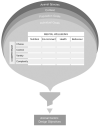Welfare Through Competence: A Framework for Animal-Centric Technology Design
- PMID: 35847650
- PMCID: PMC9280685
- DOI: 10.3389/fvets.2022.885973
Welfare Through Competence: A Framework for Animal-Centric Technology Design
Abstract
Digital technologies offer new ways to ensure that animals can lead a good life in managed settings. As interactive enrichment and smart environments appear in zoos, farms, shelters, kennels and vet facilities, it is essential that the design of such technologies be guided by clear, scientifically-grounded understandings of what animals need and want, to be successful in improving their wellbeing. The field of Animal-Computer Interaction proposes that this can be achieved by centering animals as stakeholders in technology design, but there remains a need for robust methods to support interdisciplinary teams in placing animals' interests at the heart of design projects. Responding to this gap, we present the Welfare through Competence framework, which is grounded in contemporary animal welfare science, established technology design practices and applied expertise in animal-centered design. The framework brings together the "Five Domains of Animal Welfare" model and the "Coe Individual Competence" model, and provides a structured approach to defining animal-centric objectives and refining them through the course of a design project. In this paper, we demonstrate how design teams can use this framework to promote positive animal welfare in a range of managed settings. These much-needed methodological advances contribute a new theoretical foundation to debates around the possibility of animal-centered design, and offer a practical agenda for creating technologies that support a good life for animals.
Keywords: animal technology; animal welfare; animal-centric design; animal-computer interaction; animals; digital enrichment; interaction design.
Copyright © 2022 Webber, Cobb and Coe.
Conflict of interest statement
The authors declare that the research was conducted in the absence of any commercial or financial relationships that could be construed as a potential conflict of interest.
Figures
Similar articles
-
A Framework for Using Epidemiology in Animal Welfare Science.J Appl Anim Welf Sci. 2023 Jul-Sep;26(3):361-373. doi: 10.1080/10888705.2021.1981902. Epub 2021 Oct 4. J Appl Anim Welf Sci. 2023. PMID: 34606732 Review.
-
The agency domain and behavioral interactions: assessing positive animal welfare using the Five Domains Model.Front Vet Sci. 2023 Nov 2;10:1284869. doi: 10.3389/fvets.2023.1284869. eCollection 2023. Front Vet Sci. 2023. PMID: 38026638 Free PMC article. Review.
-
The application and deployment of welfare technology in Swedish municipal care: a qualitative study of procurement practices among municipal actors.BMC Health Serv Res. 2021 Sep 6;21(1):918. doi: 10.1186/s12913-021-06944-w. BMC Health Serv Res. 2021. PMID: 34488740 Free PMC article.
-
Programmatic approaches to assessing and improving animal welfare in zoos and aquariums.Zoo Biol. 2009 Nov;28(6):519-30. doi: 10.1002/zoo.20260. Zoo Biol. 2009. PMID: 19593774 Review.
-
Two Domains to Five: Advancing Veterinary Duty of Care to Fulfil Public Expectations of Animal Welfare Expertise.Animals (Basel). 2021 Dec 8;11(12):3504. doi: 10.3390/ani11123504. Animals (Basel). 2021. PMID: 34944280 Free PMC article. Review.
Cited by
-
Handling and Training of Wild Animals: Evidence and Ethics-Based Approaches and Best Practices in the Modern Zoo.Animals (Basel). 2023 Jul 9;13(14):2247. doi: 10.3390/ani13142247. Animals (Basel). 2023. PMID: 37508025 Free PMC article. Review.
-
Welfare and Enrichment of Managed Nocturnal Species, Supported by Technology.Animals (Basel). 2024 Aug 16;14(16):2378. doi: 10.3390/ani14162378. Animals (Basel). 2024. PMID: 39199912 Free PMC article.
-
Human-animal interactions and machine-animal interactions in animals under human care: A summary of stakeholder and researcher perceptions and future directions.Anim Welf. 2024 May 9;33:e27. doi: 10.1017/awf.2024.23. eCollection 2024. Anim Welf. 2024. PMID: 38751800 Free PMC article. Review.
-
Current Perspectives on the Challenges of Implementing Assistance Dogs in Human Mental Health Care.Vet Sci. 2023 Jan 15;10(1):62. doi: 10.3390/vetsci10010062. Vet Sci. 2023. PMID: 36669063 Free PMC article. Review.
-
Animal Welfare, Agency, and Animal-Computer Interaction.Animals (Basel). 2025 Jan 15;15(2):219. doi: 10.3390/ani15020219. Animals (Basel). 2025. PMID: 39858219 Free PMC article.
References
-
- Mancini C. Animal-computer interaction: a manifesto. Interactions. (2011) 18:69–73. 10.1145/1978822.1978836 - DOI
-
- North S, Mancini C. Frameworks for ACI: animals as stakeholders in the design process. Interactions. (2016) 23:34–6. 10.1145/2946043 - DOI
-
- French F, Mancini C, Sharp H. Exploring research through design in animal computer interaction. In: Proceedings of the Fourth International Conference on Animal-Computer Interaction, ACI2017. New York, NY: ACM; (2017). 10.1145/3152130.3152147 - DOI
-
- Broom DM. The scientific assessment of animal welfare. Appl Anim Behav Sci. (1988) 20:5–19. 10.1016/0168-1591(88)90122-0 - DOI
-
- Broom DM. Animal welfare defined in terms of attempts to cope with the environment. Acta Agric Scand Sec Anim Sci Suppl. (1996) 27:22–8.
LinkOut - more resources
Full Text Sources
Research Materials
Miscellaneous




